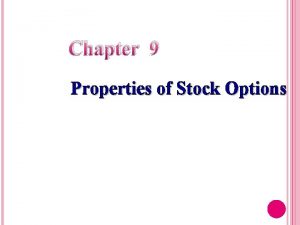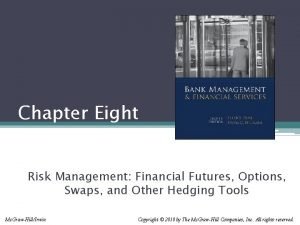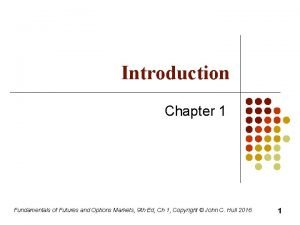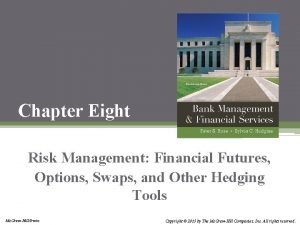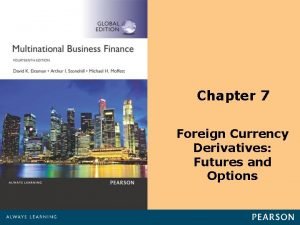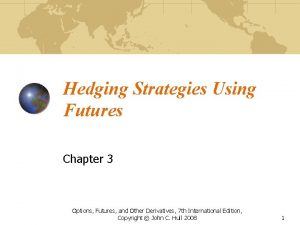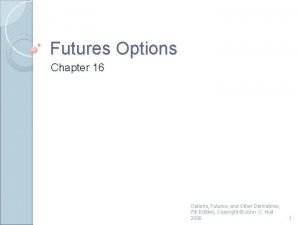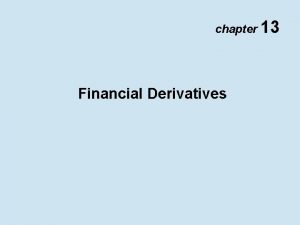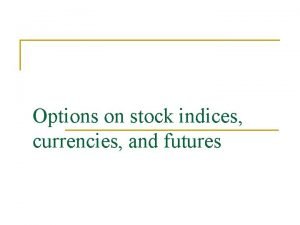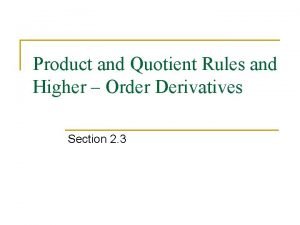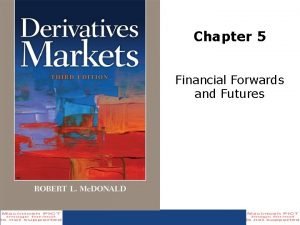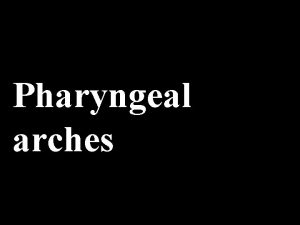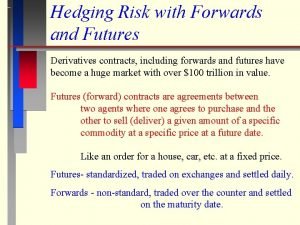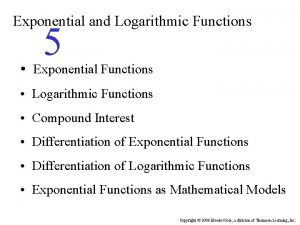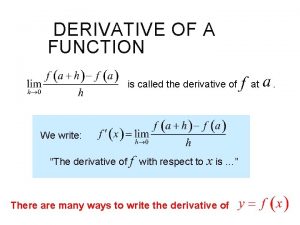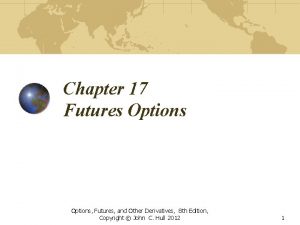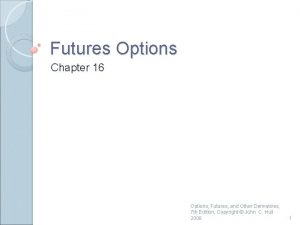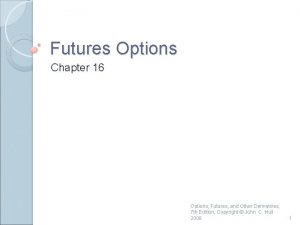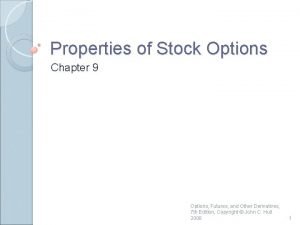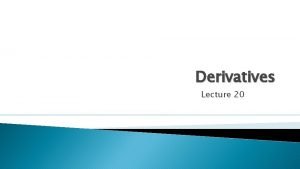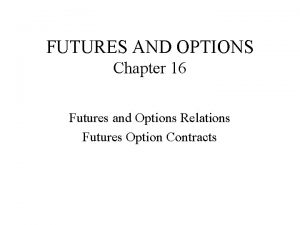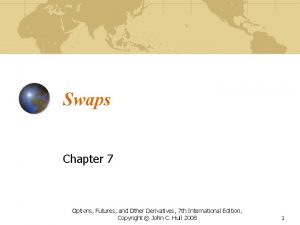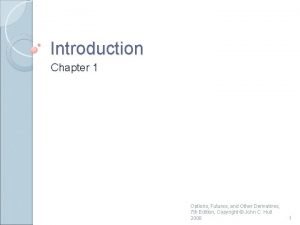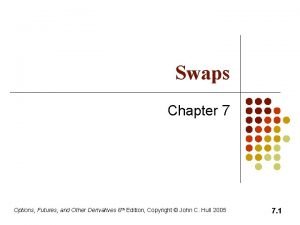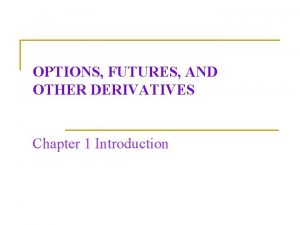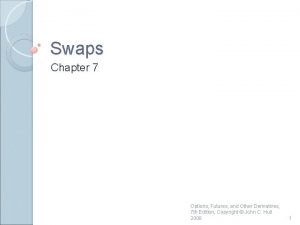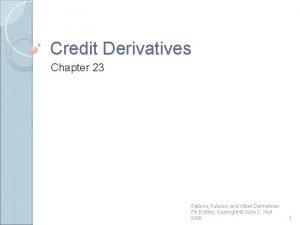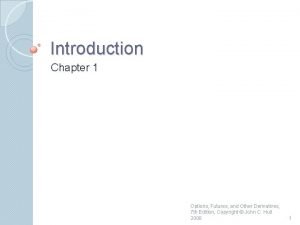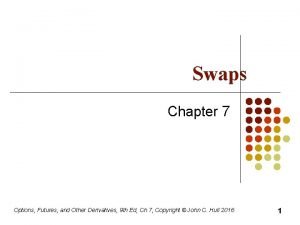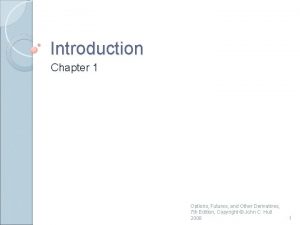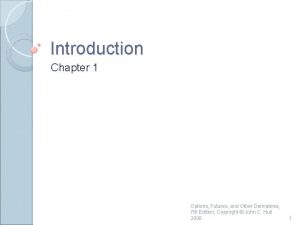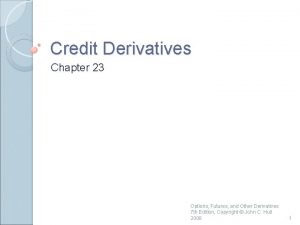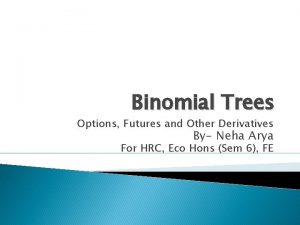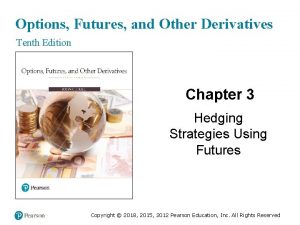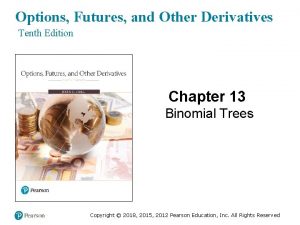Properties of Stock Options Futures and Other Derivatives




























- Slides: 28

Properties of Stock Options, Futures, and Other Derivatives 6 th Edition, Copyright © John C. Hull 2005 Chapter 9. 1

Notation l c : European call l l option price p : European put option price S 0 : Stock price today K : Strike price T : Life of option : Volatility of stock price l C : American Call option l l price P : American Put option price ST : Stock price at option maturity D : Present value of dividends during option’s life r : Risk-free rate for maturity T with cont comp Options, Futures, and Other Derivatives 6 th Edition, Copyright © John C. Hull 2005 9. 2

Effect of Variables on Option Pricing (Table 9. 1, page 206) Variable S 0 K T r D c + – ? + + – p – +? + – + C + – + + + – Options, Futures, and Other Derivatives 6 th Edition, Copyright © John C. Hull 2005 P – + + + – + 9. 3

American vs European Options An American option is worth at least as much as the corresponding European option C c P p Options, Futures, and Other Derivatives 6 th Edition, Copyright © John C. Hull 2005 9. 4

Upper and Lower Bounds on Options Prices Upper Bounds: No matter what, the call option can never be worth more that the stock S 0 c and S 0 C If this is not true, an arbitrageur could easily make a riskless profit by buying the stock and selling the call option Options, Futures, and Other Derivatives 6 th Edition, Copyright © John C. Hull 2005 9. 5

Upper and Lower Bounds on Options Prices Upper Bounds: No matter what, the put option can never be worth more that the strike price K p and K P Ke-r. T p If this is not true, an arbitrageur could easily make a riskless profit by writing the option and investing the proceeds Options, Futures, and Other Derivatives 6 th Edition, Copyright © John C. Hull 2005 9. 6

Lower Bounds in Call Options l l c S 0 - Ke-r. T Suppose that c=3 S 0 = 20 T=1 r = 10% K = 18 D=0 Then, S 0 - Ke-r. T = 3. 71 Is there an arbitrage opportunity? Options, Futures, and Other Derivatives 6 th Edition, Copyright © John C. Hull 2005 9. 7

Lower Bounds in Call Options l l If c=3 < S 0 - Ke-r. T, an arbitrageur can short the stock and buy the call to provide a cash inflow of 20 -3=17. If invested for 1 year the $17 grows to $18. 79 At maturity, if the stock price is greater than $18, the arbitrageur exercises the option for $18, closes out the short position, and makes a profit of $18. 79 -$18=$0. 79 If the stock price is lower than $18, the stock is bought in the market and the short position is closed out. If the stock price is $17, the arbitrageur gains: $18. 79 -$17=$1. 79 Options, Futures, and Other Derivatives 6 th Edition, Copyright © John C. Hull 2005 9. 8

Lower Bounds in Call Options Consider the following two portfolios: Portfolio A: one European call option plus one amount of cash equal to Ke-r. T, Portfolio B: one share Options, Futures, and Other Derivatives 6 th Edition, Copyright © John C. Hull 2005 9. 9

Lower Bounds in Call Options Portfolio A 1. The cash, if invested at r, grows to K. 2. If ST>K the option is exercised and the portfolio worth ST. 3. If ST<K the call expires worthless and the portfolio is worth K. Hence, at time T, portfolio A is worth max(ST, K ) Options, Futures, and Other Derivatives 6 th Edition, Copyright © John C. Hull 2005 9. 10

Lower Bounds in Call Options Portfolio B 1. Portfolio B is worth ST at time T. Hence, portfolio A is always worth as much as, and can be worth more than portfolio B. This must also be true today. Thus: c + Ke-r. T S 0 or c S 0 - Ke-r. T Options, Futures, and Other Derivatives 6 th Edition, Copyright © John C. Hull 2005 9. 11

Lower Bounds in Put options p Ke -r. T–S 0 l l Suppose that p =1 T = 0. 5 K = 40 S 0 = 37 r =5% D =0 then, Ke -r. T–S 0 = 2. 01 Is there an arbitrage opportunity? Options, Futures, and Other Derivatives 6 th Edition, Copyright © John C. Hull 2005 9. 12

Lower Bounds in Put Options l l If p=1 < Ke-r. T - S 0, an arbitrageur can borrow $38 for 6 months to buy both the put and the stock. At the end of the 6 months he pays back $38. 96 At maturity, if the stock price is below $40, the arbitrageur exercises the option to sell the stock for $40, repays the loan, and makes a profit of $40 -$38. 96=$1. 04 If the stock price is greater than $40, the arbitrageur discards the option, sells the stock, and repays the loan. If for example the stock price is $42: $42 -$38. 96=$3. 04 Options, Futures, and Other Derivatives 6 th Edition, Copyright © John C. Hull 2005 9. 13

Lower Bounds in Put Options Consider the following two portfolios: Portfolio C: one European put option plus one share, Portfolio D: an amount of cash equal to Ke-r. T Options, Futures, and Other Derivatives 6 th Edition, Copyright © John C. Hull 2005 9. 14

Lower Bounds in Put Options Portfolio C 1. If ST<K the option is exercised and the portfolio becomes worth K. 2. If ST>K the put expires worthless and the portfolio is worth ST. Hence, at time T, portfolio C is worth max(ST, K ) Options, Futures, and Other Derivatives 6 th Edition, Copyright © John C. Hull 2005 9. 15

Lower Bounds in Call Options Portfolio D 1. Assuming the cash is invested at r, portfolio D is worth K at time T. Hence, portfolio C is always worth as much as, and can be worth more than portfolio D. This must also be true today. Thus: p + S 0 Ke-r. T or p Ke-r. T - S 0 Options, Futures, and Other Derivatives 6 th Edition, Copyright © John C. Hull 2005 9. 16

Put-Call Parity; No Dividends (Equation 9. 3, page 212) l l l Consider the following 2 portfolios: l Portfolio A: European call on a stock + PV of the strike price in cash l Portfolio C: European put on the stock + the stock Both are worth max(ST , K ) at the maturity of the options They must therefore be worth the same today. This means that c+ -r. T Ke = p + S 0 Options, Futures, and Other Derivatives 6 th Edition, Copyright © John C. Hull 2005 9. 17

Arbitrage Opportunities l l Suppose that c =3 S 0 = 31 T = 0. 25 r = 10% K =30 D=0 What are the arbitrage possibilities when p = 2. 25 ? p=1? Options, Futures, and Other Derivatives 6 th Edition, Copyright © John C. Hull 2005 9. 18

Put-Call Parity l From Put-Call Parity: c + Ke -r. T = p + S 0 or p = c + Ke -r. T - S 0 = 1. 26 Options, Futures, and Other Derivatives 6 th Edition, Copyright © John C. Hull 2005 9. 19

Arbitrage when p=2. 25 1. 2. 3. 4. l l Buy call for $3 Short Put to realize $2. 25 Short the stock to realize $31 Invest $30. 25 for 3 months If ST > 30, receive $31. 02 from investment, exercise call to buy stock for $30. Net profit = $1. 02 If ST < 30, receive $31. 02 from investment, put exercised: buy the stock for $30. Net profit = $1. 02 Options, Futures, and Other Derivatives 6 th Edition, Copyright © John C. Hull 2005 9. 20

Arbitrage when p=1 1. 2. 3. 4. l l Borrow $29 for 3 months Short call to realize $3 Buy put for $1 Buy the stock for $31. If ST > 30, call exercised: sell stock for $30. Use $29. 73 to repay the loan. Net profit = $0. 27 If ST < 30, exercise put to sell stock for $30. Use 29. 73 to repay the loan. Net profit = $0. 27 Options, Futures, and Other Derivatives 6 th Edition, Copyright © John C. Hull 2005 9. 21

Early Exercise l l l Usually there is some chance that an American option will be exercised early An exception is an American call on a non-dividend paying stock This should never be exercised early Options, Futures, and Other Derivatives 6 th Edition, Copyright © John C. Hull 2005 9. 22

An Extreme Situation For an American call option: S 0 = 100; T = 0. 25; K = 60; D = 0 Should you exercise immediately? l What should you do if l you want to hold the stock for the next 3 months? you do not feel that the stock is worth holding for the next 3 months? Options, Futures, and Other Derivatives 6 th Edition, Copyright © John C. Hull 2005 9. 23

Reasons For Not Exercising a Call Early (No Dividends) l l l No income is sacrificed Payment of the strike price is delayed Holding the call provides insurance against stock price falling below strike price Options, Futures, and Other Derivatives 6 th Edition, Copyright © John C. Hull 2005 9. 24

Should Puts Be Exercised Early ? Are there any advantages to exercising an American put when S 0 = 60; T = 0. 25; r=10% K = 100; D = 0 Options, Futures, and Other Derivatives 6 th Edition, Copyright © John C. Hull 2005 9. 25

The Impact of Dividends on Lower Bounds to Option Prices (Equations 9. 5 and 9. 6, pages 218 -219) Consider the following two portfolios: Portfolio A: one European call option plus one amount of cash equal to D+Ke-r. T, Portfolio B: one share Then, using the similar arguments as before: Options, Futures, and Other Derivatives 6 th Edition, Copyright © John C. Hull 2005 9. 26

The Impact of Dividends on Lower Bounds to Option Prices (Equations 9. 5 and 9. 6, pages 218 -219) Consider the following two portfolios: Portfolio C: one European put option plus one share, Portfolio D: an amount of cash equal to D+ Ke-r. T Then, using the similar arguments as before: Options, Futures, and Other Derivatives 6 th Edition, Copyright © John C. Hull 2005 9. 27

Put-Call Parity; Dividends (Equation 9. 7, page 219) l l l Consider the following 2 portfolios: l Portfolio A: European call on a stock + PV of the strike price in cash + D l Portfolio C: European put on the stock + the stock Both are worth max(ST , K ) at the maturity of the options They must therefore be worth the same today. This means that c+D+ -r. T Ke = p + S 0 Options, Futures, and Other Derivatives 6 th Edition, Copyright © John C. Hull 2005 9. 28
 Options futures and other derivatives
Options futures and other derivatives Properties of stock options
Properties of stock options Options futures and risk management
Options futures and risk management Forward vs option
Forward vs option Traders in financial futures
Traders in financial futures Currency futures
Currency futures Tailing the hedge
Tailing the hedge Put call parity
Put call parity Advantages and disadvantages of derivatives
Advantages and disadvantages of derivatives Eurex dividend futures
Eurex dividend futures Putcall parity
Putcall parity Bmy finviz
Bmy finviz What is options
What is options Long-term debt preferred stock and common stock
Long-term debt preferred stock and common stock Characteristics of common shares
Characteristics of common shares Fungsi soup
Fungsi soup Stock initial
Stock initial What is intensive in chemistry
What is intensive in chemistry Physical properties and chemical properties
Physical properties and chemical properties Self initiated other repair examples
Self initiated other repair examples Product and quotient rules and higher order derivatives
Product and quotient rules and higher order derivatives Futures and forwards
Futures and forwards What is the principal method used to thicken tomato sauce
What is the principal method used to thicken tomato sauce Cleft and pouch
Cleft and pouch Hedging in forward market
Hedging in forward market Logarithm formula
Logarithm formula Log and exponential derivatives
Log and exponential derivatives Derivative of a constant
Derivative of a constant Carboxylic acids and their derivatives
Carboxylic acids and their derivatives

